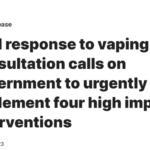What You Need to Know About Vegetable Glycerine in E-Liquids
One of the main ingredients in vape juice, vegetable glycerine has an important role in your vaping experience.
Vegetable glycerine (VG) is a vegetable-based ingredient widely used in E-Liquids for vaping. It’s known for creating thicker vapour clouds while also providing a smoother vape experience. But what else do you need to know about vegetable glycerine? Read on to find out everything there is to know about VG in vape juice.

What is vegetable glycerine?
Vegetable glycerine (VG), is a clear, odourless liquid that has a sweet taste and is derived from vegetable oils. It’s widely used in E-Liquids for vaping as it produces vapour clouds more easily than propylene glycol (PG). VG also has some additional beneficial properties, such as being an emulsifier, thickener, and humectant. As it is derived from vegetables, VG can be considered a more “natural” ingredient than PG.
When used in E-Liquids for vaping, VG has the added advantage of providing a smoother vape experience compared to other E-Liquid ingredients. This is why 50/50 and 30/70 VG ratios are considered smoother to vape.
Is vegetable glycerine safe?
VG is generally recognised as safe (GRAS) by the US Food and Drug Administration. As VG is vegetable-based, it has a much lower toxicity than PG or nicotine, so it’s safe to use in E-Liquids for vaping. Of course though, like many things, there is a potential for an allergic reaction, which, although rare, can happen.
When used in vaping it can potentially result in some of the usual side effects of vaping such as headaches, nausea and stomach upset. Vaping is widely recognised as being 95% less harmful than smoking cigarettes however there is still potential harm involved. It is for this reason why vaping is suggested only for smokers looking to quit cigarettes – those who have never smoked should not use vapes.
Benefits of vegetable glycerine in E-Liquids
VG is an effective emulsifier which means that it helps to mix the other E-Liquid ingredients together, including any flavourings. It’s also a thickener which increases the thickness of the vape juice and reduces leaking from tanks. If you notice your E-Liquid is leaking a lot check the ratio, you could benefit from choosing a 50/50 or 30/70! Finally, vegetable glycerine is a humectant – this means it absorbs moisture into the air, making E-Liquids less prone to spoilage and extending the shelf life.
What else uses vegetable glycerine?
Vegetable glycerine has a range of uses beyond E-Liquids for vaping. It’s used as an ingredient in food, cosmetics and pharmaceuticals, and it’s even used in some laundry detergents!
It’s also used as a sweetener in some food products and beverages, as it has a naturally sweet taste. For other foods, it acts as the emulsifier to help keep products moist and blend oil and water elements perfectly. The next time you buy some baked goods from the supermarket, check if yours has VG included, you’d be surprised.
In cosmetics, vegetable glycerine is commonly used in moisturisers, lotions and other skin care products due to its emollient properties. An emollient is an ingredient that helps to soothe, soften and moisturise the skin. If you use such products and notice a skin reaction you could be allergic to VG – make sure to check with a doctor if this does happen!
It’s also used as a solvent in some pharmaceuticals and is an effective vegetable-based alternative to animal-based glycerine. Finally, vegetable glycerine can be used in laundry detergents to help break down tough stains and fabric softeners, due to its humectant properties. Basically, vegetable glycerine is a very versatile substance.
High vegetable glycerine ratio vaping experience
When you opt for a 30/70 PG/VG ratio E-Liquid, the vegetable glycerine content is much higher than the other ingredients. This means that your vape juice will produce thicker clouds of vapour compared to a 50/50 PG/VG ratio, or anything with a lower vegetable glycerine content. The higher VG content also results in a smoother vape experience – this is because vegetable glycerine has a slightly thicker consistency than propylene glycol and so it doesn’t irritate your throat as much.
Just make sure to keep an eye on your vegetable glycerine ratio, as if it’s too low it can cause flooding of your coil and lead to a less enjoyable vaping experience.
High vegetable glycerine ratios are most commonly used for sub-ohm vaping because they produce a thicker cloud of vapour and can help to prevent a dry hit. If you’re looking to increase your cloud production and have a smoother vape experience, then look for an E-Liquid that’s 30/70 (PG/VG) or higher. It’s important to remember though that VG is naturally a sweet compound so vape juice with more VG is likely to impact the flavour.
Just to sum up…
In conclusion, vegetable glycerine is a versatile ingredient used in E-Liquids for vaping, food products, cosmetics and pharmaceuticals. It’s an effective emulsifier which helps to mix ingredients together and also acts as a thickener and humectant. When it comes to vaping specifically, vegetable glycerine can help create thicker clouds of vapour and a smoother vaping experience. Higher vegetable glycerine ratios are most commonly used for sub-ohm vaping as they can help prevent a dry hit, however it’s important to remember that VG is naturally sweet so vape juice with more VG is likely to affect the flavour.





100
Your article helped me a lot, is there any more related content? Thanks!
Joesph Reagey
I’m impressed, I must say. Actually hardly ever do I encounter a weblog that’s each educative and entertaining, and let me let you know, you may have hit the nail on the head. Your idea is outstanding; the issue is one thing that not sufficient individuals are talking intelligently about. I’m very completely happy that I stumbled throughout this in my seek for one thing relating to this.
SightCare
There may be noticeably a bundle to learn about this. I assume you made sure nice factors in features also.
Pronerve6 review
Awsome article and right to the point. I am not sure if this is truly the best place to ask but do you folks have any ideea where to get some professional writers? Thanks in advance 🙂
tonic greens reviews
Tonic Greens: An Overview. Introducing Tonic Greens, an innovative immune support supplement
erecprime reviews
What Is ErecPrime? ErecPrime is a male enhancement supplement that will help with improving one’s sexual experience.
Fitspresso
I visited a lot of website but I conceive this one has got something extra in it in it
Fitspresso review
Excellent goods from you, man. I have understand your stuff previous to and you’re just too excellent. I really like what you’ve acquired here, really like what you’re saying and the way in which you say it. You make it enjoyable and you still care for to keep it sensible. I cant wait to read much more from you. This is really a wonderful website.
SightCare review
Absolutely indited written content, Really enjoyed looking through.
going here
I am glad to be one of several visitors on this outstanding web site (:, thanks for putting up.
have a peek here
You are my inspiration, I have few web logs and occasionally run out from post :). “He who controls the past commands the future. He who commands the future conquers the past.” by George Orwell.
PotentStream Review
Some genuinely great content on this web site, thank you for contribution. “We are always in search of the redeeming formula, the crystallizing thought.” by Etty Hillesum.
Sugar Defender
I as well as my friends were found to be reading the excellent pointers found on your site and so suddenly I got a horrible suspicion I never expressed respect to you for those strategies. The ladies are already absolutely thrilled to learn all of them and have now certainly been loving these things. Appreciation for turning out to be considerably kind and also for getting varieties of remarkable resources most people are really desperate to learn about. My very own sincere regret for not expressing gratitude to you sooner.
cbd tee
The next time I read a blog, I hope that it doesnt disappoint me as much as this one. I mean, I know it was my choice to read, but I actually thought youd have something interesting to say. All I hear is a bunch of whining about something that you could fix if you werent too busy looking for attention.
weed shop
I do believe all the ideas you have offered for your post. They are very convincing and can definitely work. Nonetheless, the posts are very brief for novices. May you please lengthen them a bit from next time? Thanks for the post.
boutique cbd en ligne
Thanks for every one of your effort on this blog. My mum loves working on internet research and it’s obvious why. We all notice all relating to the dynamic way you convey rewarding guidelines through the website and even welcome response from website visitors about this subject matter and our favorite daughter has always been discovering a lot of things. Enjoy the rest of the year. Your conducting a stunning job.
Fitspresso
Wow! This could be one particular of the most beneficial blogs We have ever arrive across on this subject. Basically Fantastic. I am also a specialist in this topic so I can understand your effort.
adm 4d
I’ve recently started a web site, the info you offer on this website has helped me tremendously. Thank you for all of your time & work.
The Genius Wave
Wow, wonderful blog structure! How lengthy have you ever been running a blog for? you make running a blog look easy. The whole glance of your web site is magnificent, as neatly as the content!
Fortune Tiger
I am glad to be a visitant of this gross site! , thankyou for this rare information! .
cognicare pro reviews
What is CogniCare Pro? CogniCare Pro is 100 natural and safe to take a cognitive support supplement that helps boost your memory power. This supplement works greatly for anyone of any age and without side effects
fitspresso reviews
FitSpresso: What Is It?FitSpresso is a natural weight loss aid designed for individuals dealing with stubborn weight gain. It is made using only science-backed natural ingredients.
Fitspresso review
Hmm it looks like your blog ate my first comment (it was super long) so I guess I’ll just sum it up what I wrote and say, I’m thoroughly enjoying your blog. I as well am an aspiring blog blogger but I’m still new to everything. Do you have any tips for beginner blog writers? I’d genuinely appreciate it.
Glucofreedom
I like this website its a master peace ! Glad I noticed this on google .
joint genesis
There is noticeably a bundle to know about this. I assume you made certain nice points in features also.
Prodentim
Great website! I am loving it!! Will be back later to read some more. I am taking your feeds also
Quietum Plus
Hello there! Would you mind if I share your blog with my facebook group? There’s a lot of folks that I think would really appreciate your content. Please let me know. Thank you
Denticore Review
I’m really enjoying the design and layout of your website. It’s a very easy on the eyes which makes it much more enjoyable for me to come here and visit more often. Did you hire out a developer to create your theme? Exceptional work!
Lottery Defeater
I like this web blog so much, saved to my bookmarks.
Fitspresso
Great post. I am facing a couple of these problems.
CogniCare pro
Helpful information. Lucky me I discovered your web site accidentally, and I am stunned why this coincidence did not happened earlier! I bookmarked it.
Puravive
Great post. I was checking constantly this blog and I am impressed! Very useful information specifically the last part 🙂 I care for such information much. I was looking for this particular info for a very long time. Thank you and good luck.
how to hire a hacker
Hiya very nice website!! Guy .. Beautiful .. Superb .. I’ll bookmark your web site and take the feeds alsoKI’m satisfied to search out numerous useful information here in the post, we’d like work out more techniques in this regard, thank you for sharing. . . . . .
resource
Greetings! I know this is kinda off topic but I was wondering if you knew where I could get a captcha plugin for my comment form? I’m using the same blog platform as yours and I’m having problems finding one? Thanks a lot!
webdesign
With havin so much content do you ever run into any issues of plagorism or copyright violation? My website has a lot of unique content I’ve either written myself or outsourced but it appears a lot of it is popping it up all over the internet without my agreement. Do you know any solutions to help prevent content from being stolen? I’d truly appreciate it.
renewreviews
I have read some good stuff here. Definitely worth bookmarking for revisiting. I surprise how so much attempt you place to make the sort of excellent informative site.
Fitspresso review
Hello, you used to write wonderful, but the last several posts have been kinda boringK I miss your tremendous writings. Past several posts are just a little bit out of track! come on!
Tonic Greens
I like what you guys are up also. Such intelligent work and reporting! Keep up the excellent works guys I¦ve incorporated you guys to my blogroll. I think it will improve the value of my site 🙂
The Genius Wave
Nice post. I learn something more challenging on different blogs everyday. It will always be stimulating to read content from other writers and practice a little something from their store. I’d prefer to use some with the content on my blog whether you don’t mind. Natually I’ll give you a link on your web blog. Thanks for sharing.
java burn reviews
It’s actually a cool and helpful piece of information. I’m glad that you shared this helpful info with us. Please keep us up to date like this. Thanks for sharing.
nano defense pro reviews
Do you mind if I quote a few of your posts as long as I provide credit and sources back to your blog? My blog site is in the exact same niche as yours and my visitors would really benefit from a lot of the information you present here. Please let me know if this alright with you. Thanks!
fitspresso reviews
Hello.This post was really interesting, particularly since I was investigating for thoughts on this topic last Sunday.
Neotonics
I like this weblog very much, Its a really nice position to read and get info .
Neotonics gummies review
Some really nice and utilitarian information on this internet site, too I conceive the design contains great features.
Renew
Hey, I think your site might be having browser compatibility issues. When I look at your website in Firefox, it looks fine but when opening in Internet Explorer, it has some overlapping. I just wanted to give you a quick heads up! Other then that, terrific blog!
Denticore
I’ll right away take hold of your rss as I can not find your e-mail subscription hyperlink or e-newsletter service. Do you have any? Please permit me realize so that I could subscribe. Thanks.
Tonic Greens
I’ve recently started a site, the info you offer on this site has helped me greatly. Thank you for all of your time & work. “The word ‘genius’ isn’t applicable in football. A genius is a guy like Norman Einstein.” by Joe Theismann.
fertige joints online bestellen
Its wonderful as your other articles : D, thanks for posting. “I catnap now and then, but I think while I nap, so it’s not a waste of time.” by Martha Stewart.
cbn effet psychoactif
I really appreciate this post. I?¦ve been looking everywhere for this! Thank goodness I found it on Bing. You’ve made my day! Thank you again
prodentim
Hey very cool blog!! Guy .. Excellent .. Superb .. I will bookmark your blog and take the feeds also…I’m happy to seek out numerous helpful information right here within the post, we’d like develop more techniques on this regard, thank you for sharing. . . . . .
tonic greens
You really make it seem so easy with your presentation but I find this matter to be actually something which I think I would never understand. It seems too complex and extremely broad for me. I am looking forward for your next post, I will try to get the hang of it!
prodentim review
Some really wonderful content on this website , thankyou for contribution.
pig sweat poppers
Fantastic web site. A lot of helpful information here. I am sending it to several pals ans also sharing in delicious. And of course, thank you to your effort!
nom de famille en anglais
Thanks for sharing excellent informations. Your website is so cool. I’m impressed by the details that you¦ve on this site. It reveals how nicely you understand this subject. Bookmarked this website page, will come back for more articles. You, my friend, ROCK! I found simply the information I already searched all over the place and simply could not come across. What a great site.
binance
Can you be more specific about the content of your article? After reading it, I still have some doubts. Hope you can help me.
binance
Thanks for sharing. I read many of your blog posts, cool, your blog is very good.
atvērt binance kontu
Thanks for sharing. I read many of your blog posts, cool, your blog is very good.
CBD Oil Buy
I am continually invstigating online for tips that can benefit me. Thx!
Premium CBD Öl Kaufen
I appreciate, cause I found just what I was looking for. You’ve ended my four day long hunt! God Bless you man. Have a great day. Bye
binance bonus za prijavo
Can you be more specific about the content of your article? After reading it, I still have some doubts. Hope you can help me.
Mendaftar di www.binance.com
Thank you for your sharing. I am worried that I lack creative ideas. It is your article that makes me full of hope. Thank you. But, I have a question, can you help me?
bono de registro en Binance
Thanks for sharing. I read many of your blog posts, cool, your blog is very good.
شركة كلينر للتنظيف
تتميز شركة تنظيف سجاد بالرياض بتوفير خدمات شاملة تشمل كافة أنواع السجاد والأقمشة سواء كانت صوفية أو صناعية وذلك باستخدام أحدث التقنيات والمعدات المتطورة في مجال التنظيف كما تتمتع هذه الشركات بخبرة واسعة في التعامل مع مختلف أنواع البقع والأوساخ التي قد تتراكم على السجاد.
شركة تنظيف سجاد بالرياض
samalemarat
نقدم لك في شركة تنظيف مكيفات في دبي خدمة تنظيف شاملة حيث نضمن لك كفاءة تبريد ممتازة وجودة هواء نقية فريقنا من الفنيين المدربين حيث نستخدم أحدث الأدوات والتقنيات المتقدمة كما نقوم بتنظيف شامل للمكيف وإزالة الأتربة والبكتيريا المتراكمة داخل الجهاز لضمان أداء صحي ومثالي.
شركة تنظيف مكيفات في دبي
شركة النور للتسليك والتنظيف
وايت شفط بيارات بالجبيل لديه القدرة الهائلة في شفط و تنظيف البيارات فلا شك أن مشاكل الصرف لا تنتهي لذا لابد من الاتصال بالشركة المناسبة والمتخصصة في مجال المجاري حتى يتم التعامل مع المشكلة بجودة وكفاءة عالية مع افضل فريق عمل وارخص الاسعار لذا هيا عزيزي العميل عليك بالتخلص من مشاكل الصرف من خلال شركة وايت تسليك وتنظيف وشفط بيارات بالجبيل.
وايت شفط بيارات بالجبيل
شركة اركان الشامل للتنظيف
شركة تنظيف بالخبر من أهم وافضل شركات التنظيف التي تسعى للوصول إلى النظافة والتعقيم والجودة العالية هذا إلى جانب الأسعار الرخيصة حيث تقدم الشركة خدمات مميزة للغاية كي تحقق للعميل كل الخدمات التي يحتاجها من تنظيف لذا هيا عزيزي العميل تواصل مع شركتنا افضل شركة تنظيف منازل بالخبر ولن تندم أبدًا.
شركة تنظيف منازل بالخبر